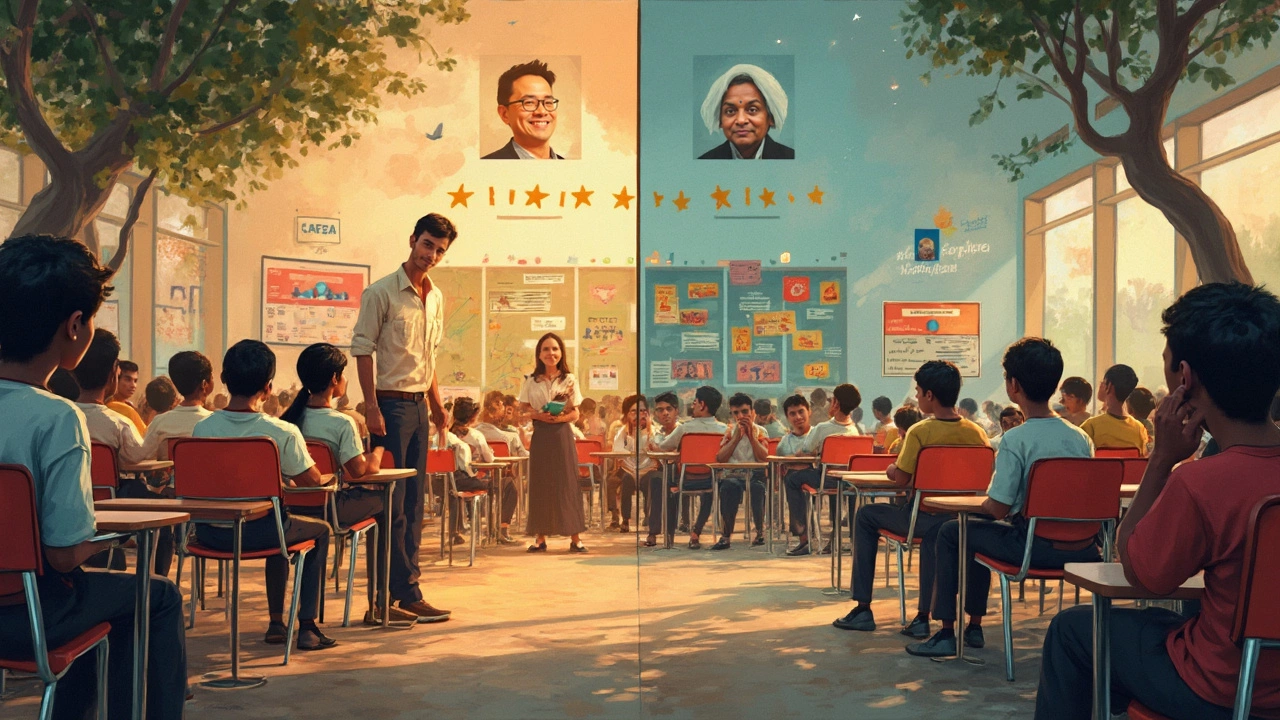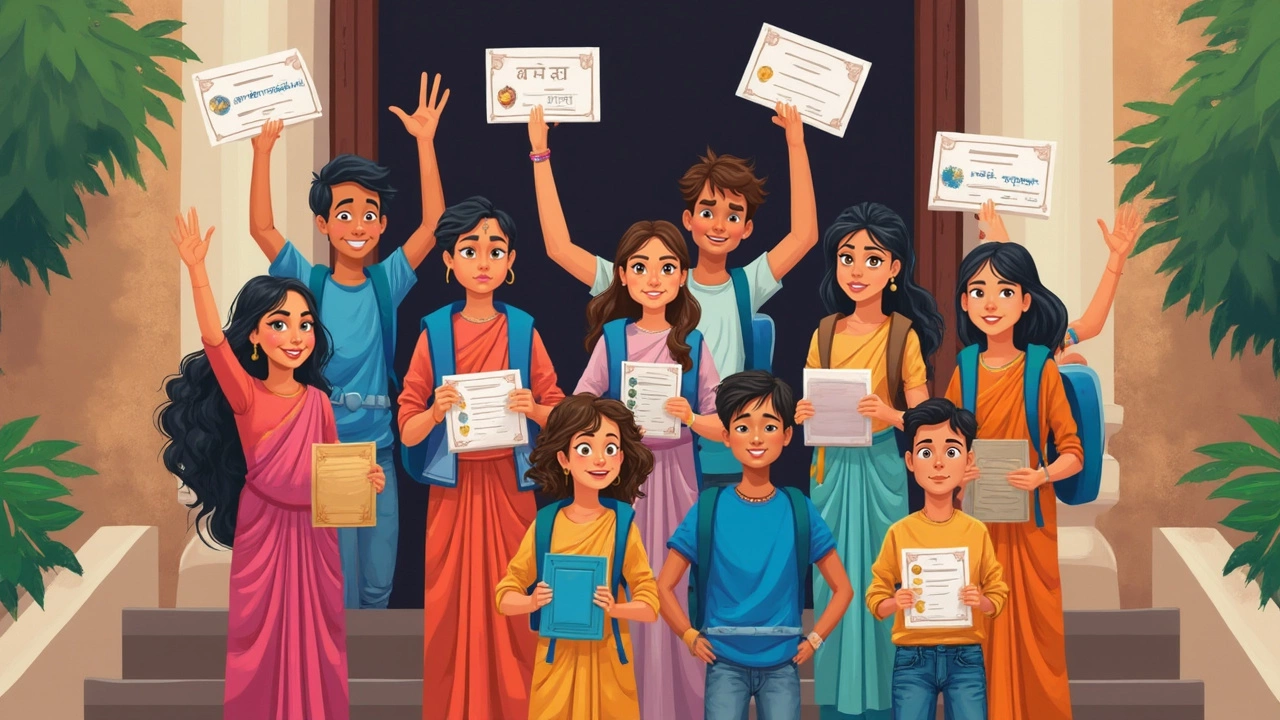Every serious IIT aspirant hears about the "best" coaching from day one. But here’s a reality check: there isn’t one magic institute that fits everyone. While gigantic names like Allen, FIITJEE, and Resonance sound legendary, the numbers behind their IITian output tell a messier story than glossy brochures let on.
For example, Allen in Kota claims thousands of selections each year. Sounds wild, right? But when you peek behind the curtain, you'll see they enroll over a hundred thousand students annually—so the actual success rate isn’t as jaw-dropping as those headline stats suggest. A small city coaching with 70 students and 14 selections could beat that percentage.
Also, don’t just fall for the brand. Every year, the top ranks feature students from unknown local or even fully online institutes, sometimes using only YouTube and PDFs. Methods matter more than the building or the town’s fame. Often, the real game-changer isn’t the institute but the support system and study culture you find inside.
- The Big Names: Kota, Hyderabad, and the Rest
- Success Rates vs Batch Size: What Matters More?
- Hidden Gems: Local and Online Coaching Centers
- What Toppers Say: Methods That Work
- Tips to Choose the Right Coaching for You
The Big Names: Kota, Hyderabad, and the Rest
If you're talking about IIT JEE coaching in India, Kota always pops up. This small city in Rajasthan has pretty much become a factory for IIT aspirants. Schools like Allen, Vibrant Academy, and Resonance pack their classes with thousands of candidates who dream big. Allen, for example, claims more than 15,000 selections in JEE Main and over 700 in JEE Advanced in 2024. Now, keep in mind, these numbers seem huge until you realize how massive their enrollments are.
Hyderabad isn't just about biryani—it's got Narayana and Sri Chaitanya, two of the country’s biggest chains. These two alone run dozens of branches, with secret sauce strategies like long-term integrated programs. In 2024, Sri Chaitanya announced over 400 selections in JEE Advanced. Narayana threw in similar numbers, but again, they teach tens of thousands. Quantity is off the charts, but so is competition within their own classes.
Other cities want in too. FIITJEE, originally from Delhi, has branches everywhere from Chennai to Indore. They often make a splash by claiming toppers or students with single-digit ranks—they reported 219 selections in the top 500 ranks in 2024, with many coming from their Delhi or South India branches.
If you look at these places, the draw isn’t just teaching but the whole ecosystem: hostel living, daily tests, peer competition, and non-stop practice. Plus, the "trial by fire" pressure cooker routine—honestly, it’s not for everyone. The numbers can look insane, but before jumping in, weigh how you handle pressure and whether that factory vibe will push you forward or burn you out.
- Kota’s Allen, Vibrant, and Resonance = huge batches, biggest headline numbers
- Hyderabad’s Narayana and Sri Chaitanya = aggressive routines, mega-branches across India
- FIITJEE (Delhi origin) = nation-wide reach, focus on single-digit JEE rankers
The bottom line: The big names create the buzz, but the success rate per student is way less glamorous than the advertisements. Think carefully about whether you’ll thrive in that high-pressure crowd, or if a smaller setup might get you further.
Success Rates vs Batch Size: What Matters More?
It’s tempting to get impressed by the number of students an institute sends to IIT each year. Seeing big numbers like “3000 selections” can make anyone think, “This must be the right place!” But here’s the catch: batch size changes everything. Massive institutes like IIT JEE bigwigs Allen and FIITJEE have thousands of students in a single city—sometimes so many they fill cricket stadiums. Sure, they send more students to IIT, but statistically, their success rate per student looks way less impressive.
Look at examples. In 2023, Kota coaching Allen reportedly enrolled over 125,000 kids for JEE coaching. About 18,000 got IIT JEE Main qualifying ranks, and only around 9,000 made it through Advanced. That’s roughly a 7% success rate, and an even smaller percentage if you look at real seats grabbed. Meanwhile, local institutes in Hyderabad, Indore, or Delhi—places you’d have to hunt for on Google Maps—sometimes produce 10-15 IITians from a batch of just 60 or 80. That’s about 15-20%. Quietly, they’re ahead if you look at ratios rather than raw numbers.
Here’s why size matters: In a huge batch, personal attention drops. It becomes easier to get lost in the crowd. Smaller groups mean teachers know your name, spot your weak points, and can actually help. You’re simply less likely to get ignored, and peer pressure can drive a group of 30 way harder than a hall of 500.
So—should you chase success rates or big names? Neither alone is enough. Dig up the real numbers. Ask the institute how many actually sit in classes (not just enroll) and how many reach Advanced. Don’t hesitate to push for these stats, because a flashy poster won’t mention percentage rates. No one talks about the silent majority who don’t make it.
The takeaway: Batch size affects everything, from doubt-solving sessions to mock test quality. Check both the total numbers and success percentages before you pick. And don’t be shy about asking point-blank, “Out of your total enrolled, how many cracked IIT last year?” If the answer dodges the ratio, that’s a red flag.

Hidden Gems: Local and Online Coaching Centers
If you think cracking the IIT JEE is only possible with big coaching brands, think again. Lots of IIT JEE toppers come from places that never make the news. Local coaching centers often don’t have shiny ads, but plenty have solid teachers, smaller batches, and personal attention that you just can’t find in a hall packed with hundreds.
Take Vidyamandir Classes in Delhi, for instance. It’s not the flashiest, but it’s had a crazy good track record with single to double-digit AIR holders almost every year. Same with Ace Academy in Hyderabad—it flies under the radar, yet it reportedly sends up to 300 students to IITs annually, despite much smaller batch sizes than Kota factories.
The online scene is turning the tables, too. In 2024, 7 out of the top 100 JEE Advanced rankers studied mainly with platforms like Unacademy, Vedantu, and Physics Wallah. During COVID, these edtechs went from backup to the main plan for loads of students. Why? Flexible schedules, cheaper costs, and high-quality teachers from across the country answering doubts in real time.
| Coaching Center | Mode | Approx. Selections (2024) | Batch Size |
|---|---|---|---|
| Vidyamandir Classes | Offline/Online | 210 | 1,200 |
| ACE Academy | Offline | 300 | 2,500 |
| Physics Wallah | Online | 170 | Estimated 5,000 |
| Vedantu | Online | 136 | Estimated 4,000 |
What makes these places gold mines is the mix of tight-knit mentoring and the ability to customize your study plan. Smaller classes mean teachers notice if you’re slipping. Online, you get instant recording replays, test series, and All-India ranks, not just classroom notes. You don’t have to be in Kota or Hyderabad anymore to get top-tier guidance.
If you’re considering a lesser-known center or online route, look at their recent JEE performance, talk to past students, and sample a few classes for teaching style. Just because a center is quiet on social media doesn’t mean it isn’t launching future IITians every single year.
What Toppers Say: Methods That Work
Every year, right after the IIT JEE results, the media flashes interviews with toppers. If you look past the usual humble replies, you’ll spot real hacks that work for anyone, not just so-called geniuses.
Almost all recent toppers—from Soham Das (AIR 1, JEE Advanced 2024) to Vasu Jain (AIR 2, 2023)—say the same thing: solving problems is king, not just reading theory.
- IIT JEE toppers rarely stick to a fixed number of hours. Instead, they set specific topic goals for each day—like finishing two tough chapters in math or building speed in tricky physics questions.
- Many use revision notebooks. According to Soham, he kept one for silly mistakes. Whenever he got something wrong, he'd jot down what tripped him up—sometimes it was rushing, sometimes misreading units.
- Mock tests are non-negotiable. Most toppers take at least one full-length test every week for the last six months. Vasu even used to simulate real exam conditions—same time, same rules, no breaks.
- Peer discussion is underrated. Instead of group study, toppers usually discuss one or two tricky problems with friends or mentors—just enough to get unstuck, not to get distracted.
Here’s a table that sums up how last year’s top 10 AIR scorers distributed their weekly prep hours by subject, based on interviews and coaching records:
| Subject | Average Hours per Week | Key Activities |
|---|---|---|
| Math | 18 | Practice, problem sets, error analysis |
| Physics | 15 | Concept revision, tricky numericals, past papers |
| Chemistry | 12 | NCERT revision, reactions, fast recall drills |
The big lesson? Toppers don’t follow a magic formula. They focus on active learning (i.e., doing, not just reading), make time for full-length mocks under exam-like conditions, and constantly review their mistakes—not just their strengths. Toss in some peer feedback and a lot of error-finding, and you’ve basically got the most effective prep recipe out there.

Tips to Choose the Right Coaching for You
Picking the right coaching for IIT JEE prep can make all the difference, but it’s easy to get lost in the flood of marketing. Let’s clear things up so you don’t waste time or money on hype.
- Batch Size and Faculty: Giant institutes might sound impressive, but if you’re sitting in a class with 300 students, personal doubt-clearing can feel like a dream. Always ask about batch size—anything above 75 is usually a red flag for attention.
- Track Record: Skip the tall claims and ask for real selection-wise stats. Some places inflate their numbers by counting repeaters or crash course kids who barely attended. Look for a list of present-year students who actually cracked the IIT, not generic pass numbers.
- Faculty Access: It's no use if the star teacher only comes for one demo and disappears. Check if the main teachers are available for one-on-one doubt sessions.
- Peer Group: Your batchmates matter. Being with motivated peers can keep you on track when the going gets tough.
- Mock Test Frequency: Institutes with weekly or biweekly mock tests help you build exam temperament and catch flaws early.
- Location and Time: Hours lost in traffic are hours lost from revision. If your city has a solid local coaching with good track record, don’t ignore it just because it’s not from Kota or Hyderabad.
Here’s what R.L. Trikha, the Director of FIITJEE, once said about choosing the right center:
"Instead of only looking at national rankings, students must visit the center, meet faculty, and gauge comfort and challenge level themselves."
To get a realistic idea, check out this data comparing some well-known institutes based on 2024 JEE Advanced selections:
| Institute | Selections | Total Students (approx.) | Selection % |
|---|---|---|---|
| Allen, Kota | 13,500 | 98,000 | 13.8% |
| FIITJEE | 8,900 | 62,000 | 14.3% |
| Resonance | 7,200 | 52,000 | 13.8% |
| Vidyalankar, Mumbai | 240 | 1,700 | 14.1% |
| Local (example: PRK Classes, Patna) | 44 | 320 | 13.7% |
As you can see, the percentage of students who actually crack JEE is pretty similar whether you study at a big factory-like place or a smaller local setup. The difference is in attention, support and fit for your style.
Before making up your mind, try a demo class, grill the faculty about their real involvement, and talk to past students—not the ones picked by the institute, but folks you reach out to on your own. Sometimes, it’s the fit more than the name that makes all the difference.
